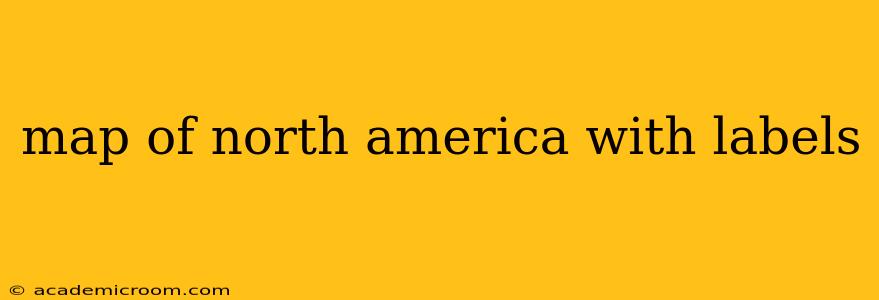North America, the third-largest continent, boasts a diverse range of landscapes, climates, and cultures. Understanding its geography is key to appreciating its rich history and vibrant present. This guide provides a comprehensive overview, touching on key geographical features and political boundaries, helping you navigate a labeled map of North America effectively.
What are the Major Physical Features of North America?
North America's physical geography is incredibly varied. From towering mountain ranges to vast plains and sprawling deserts, the continent offers a dramatic tapestry of landscapes. Key features include:
-
Rocky Mountains: This extensive mountain range stretches from northern British Columbia in Canada down to New Mexico in the United States, forming a significant continental divide. The Rockies are known for their rugged peaks, abundant wildlife, and stunning natural beauty.
-
Appalachian Mountains: Located along the eastern seaboard of North America, the Appalachians are older and less dramatic than the Rockies, but still possess significant ecological and historical importance.
-
Great Plains: This vast, relatively flat expanse of grassland stretches from the foothills of the Rockies to the Mississippi River, encompassing parts of Canada, the United States, and Mexico. Historically crucial for agriculture, the Great Plains are now home to sprawling farms and ranches.
-
Canadian Shield: A large, geologically ancient region covering much of central and eastern Canada, the Canadian Shield is characterized by its rugged terrain, rocky outcrops, and abundant lakes and rivers.
-
Coastal Plains: Stretching along the Atlantic and Gulf Coasts of North America, these relatively low-lying plains are fertile agricultural regions and sites of major population centers.
-
Mexican Plateau: A high plateau in central Mexico, it’s surrounded by mountain ranges and is a significant agricultural region.
What are the Major Countries and Regions of North America?
Politically, North America is a complex patchwork of independent nations and territories. Understanding these boundaries is essential when interpreting any labelled map:
-
United States of America (USA): The largest country by far, occupying much of the central portion of the continent.
-
Canada: Occupying the northernmost reaches of the continent, it shares a long border with the USA.
-
Mexico: Located to the south, sharing a significant border with the USA.
-
Central America: This region encompasses numerous independent countries including Guatemala, Belize, Honduras, El Salvador, Nicaragua, Costa Rica, and Panama, forming a narrow isthmus connecting North and South America. These countries are often characterized by their tropical climates and diverse ecosystems.
-
Caribbean Islands: While geographically linked to North America, the Caribbean Islands, including Cuba, Jamaica, Haiti, the Dominican Republic and many others, often considered part of a separate cultural and geopolitical region.
How Can I Find a Good Labeled Map of North America?
Many resources offer detailed, labeled maps of North America. A simple online search for "labeled map of North America" will yield numerous results. You can also find high-quality maps in atlases, geography textbooks, and educational websites. Look for maps that clearly label major geographical features, cities, and political boundaries. Consider maps that are interactive and allow for zooming and exploring different areas in greater detail.
What are Some Key Cities to Look for on a North American Map?
Identifying major cities adds another layer of understanding to any map. Some prominent cities to look for include:
- New York City (USA)
- Los Angeles (USA)
- Chicago (USA)
- Mexico City (Mexico)
- Toronto (Canada)
- Montreal (Canada)
- Vancouver (Canada)
What are the Different Climate Zones in North America?
North America's climate varies dramatically depending on latitude and altitude. From arctic conditions in the far north to tropical climates in the south, the continent experiences a wide range of weather patterns. Major climate zones include:
-
Arctic: Characterized by extremely cold temperatures, low precipitation, and long, dark winters.
-
Subarctic: Similar to the arctic but with slightly milder temperatures and shorter winters.
-
Temperate: This zone experiences a wide range of temperatures, with distinct seasons. Further categorized into humid continental, Mediterranean, marine west coast, and humid subtropical.
-
Tropical: Characterized by hot temperatures and high humidity throughout the year. Predominantly found in Central America and the Caribbean.
This guide should help you navigate a labeled map of North America with greater confidence and understanding. Remember to use a variety of resources to gain a complete picture of the continent's complex geography and political landscape.
